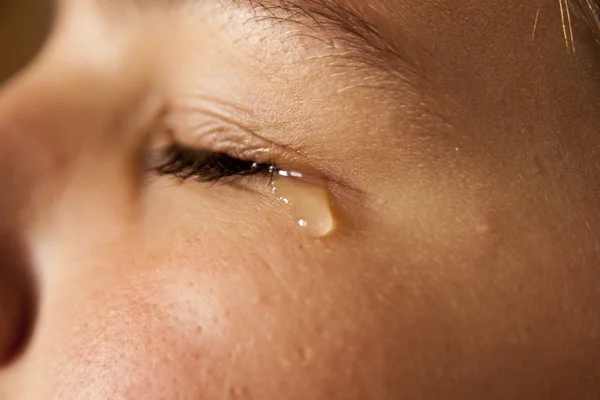Do you cry much and asking “Does crying affect your eyesight?” Well, crying is a natural physiological response characterized by the shedding of tears, often in response to emotional or physical distress, pain, joy, or other intense feelings. It is a complex and multifaceted human behavior with both emotional and physical components.
The human tear system is a sophisticated mechanism that serves to lubricate, nourish, and protect the eyes. It consists of three main layers: the lipid (oil) layer, the aqueous (water) layer, and the mucin (mucus) layer. Tears are produced by the lacrimal glands and distributed across the ocular surface through blinking and drainage.
The purpose of this topic is to explore the potential effects of crying on eyesight. By delving into the physiological and emotional aspects of crying, as well as the intricate functioning of the human tear system, Sound Health and Lasting Wealth aim to provide a comprehensive understanding of whether crying can impact visual health. This exploration will address common questions and misconceptions surrounding the relationship between crying and eyesight, ultimately contributing to a more informed perspective on this intriguing subject.
Copyright © 2024 Soundhealthandlastingwealth.
Does crying affect your eyesight?

Effects of Crying on the Eyes: Crying can benefit your eye health as it helps with lubrication, cleansing, and stress relief. Tears help lubricate the eyes, prevent dryness, and clean the eyes by flushing out particles of dust and debris that could harm vision. However, it could be bad when you cry too much. Excessive crying can have various side effects on the eyes leading to temporary effects such as blurriness, redness, and irritation around the eyes, which may be due to the increased blood flow and the chemical composition of emotional tears. Tearing up often can be a sign or symptom of an underlying problem or potential eye issue. Here’s what happens to your eyes when you cry too much;
Disadvantages of crying too much
Dry Eye Syndrome: Persistent excessive tearing may signal an underlying eye condition such as dry eye syndrome. Dry eye syndrome occurs when the eye is unable to maintain a healthy coating of tears, leading to symptoms such as blurred vision, burning, itching, or redness in the eye, and a gritty or scratchy feeling in the eye. Therefore, if you experience persistent excessive tearing or symptoms of dry eye syndrome, it is important to consult an eye doctor for a thorough evaluation and appropriate management. It is important to consult an eye doctor for a thorough evaluation.
Blepharitis: Excessive crying can lead to blepharitis, an inflammation of the eyelids. When you cry, the increased tear production can contribute to the development of blepharitis, especially if the tears are not effectively cleared from the eyes. The residue from the tears can lead to irritation and contribute to the development of blepharitis.
Other Potential Concerns: Excessive crying can lead to a range of potential concerns, including emotional and physical exhaustion, as well as the possibility of underlying mental health conditions such as burnout, anxiety, or depression. Additionally, excessive crying may be associated with hormonal imbalances or neurological conditions. In some cases, a disconnect between certain areas of the brain can lead to emotional dysregulation, resulting in uncontrollable crying. Furthermore, persistent excessive tearing can be a sign of an underlying problem, and it’s important to schedule an eye exam with an optometrist if you experience any changes in your vision, eye pain, excessive dryness, or other eye concerns.
In summary, while crying offers benefits for eye health, it is important to be mindful of any persistent or concerning eye symptoms and seek professional help when needed.
Benefits of Crying for Eye Health
The benefits of crying for eye health include:
Lubrication and Cleansing: Crying helps to lubricate the eyes, preventing dryness and maintaining comfort. Tears also play a crucial role in cleaning the eyes by flushing out particles of dust and debris that could harm vision. The antibodies in tears help fight off bacteria and viruses, reducing the risk of eye infections.
Stress Relief and Eye Health: Crying is a natural way of relieving stress, both physical and emotional. It can also promote the release of endorphins, which can help improve mood and provide a sense of well-being.
Emotional Well-being and Eye Health: Crying can have social and physiological benefits, promoting social bonding and providing relief from emotional stress. The release of tears during crying can prevent damage to the eyes, including eye infection, corneal abrasion, and corneal ulcer
Types of Tears
Tears are classified into three main types: basal tears, reflex tears, and emotional tears. Emotional tears, triggered by strong feelings such as joy and sadness, are believed to be unique to humans. They are influenced by biological, psychological, and social factors.
Emotional tears are chemically different from basal and reflex tears, containing more protein and potentially serving a social bonding function. They are produced in response to a broader range of feelings as individuals age, including physical pain, attachment-related pain, empathic, compassionate pain, societal pain, and sentimental or moral feelings.
How crying is triggered: Crying can be triggered by a range of feelings, from empathy and surprise to anger and grief. The release of emotional tears is associated with physiological and neural changes in the body, including the activation of the limbic system and the signaling of the lacrimal system to produce tears. This information provides an overview of the types of tears, the differences between emotional and reflex tears, and the triggers for crying.
Myths and Facts about Crying and Eyesight
Common Misconceptions
- Crying is a sign of weakness: Contrary to this belief, crying is a natural and healthy emotional response with both social and physiological benefits.
- Crying always indicates emotional distress: While crying is often associated with sadness, it can also be a response to various emotions, including joy and relief.
- Crying is harmful to the eyes: In fact, crying can benefit eye health by promoting lubrication, cleansing, and the release of endorphins.
Scientific Evidence and Research Findings
- Promotion of Social Bonding: Studies have shown that crying promotes social bonding, and individuals who cry while receiving comfort from others tend to feel better.
- Prevention of Eye Damage: Crying helps prevent eye infections, corneal abrasions, and ulcers by washing away irritants and debris, thus reducing the risk of infection.
- Release of Endorphins: Emotional crying can lead to the release of endorphins, which can help improve mood and provide a sense of well-being.
In summary, the scientific evidence suggests that crying offers both social and physiological benefits, including the promotion of social bonding, the prevention of eye damage, and the release of endorphins. It is not harmful to eye health and can be a natural and healthy response to various emotions.
Tips for Alleviating Crying-Related Discomfort
Eye Care During and After Crying
- Avoid rubbing your eyes while crying to prevent increased puffiness, discoloration, and potential irritation or infection
- Apply a cold compress or gently wash your face with cool water after crying to reduce puffiness and redness.
- Focus on slow, deep breaths to calm your nervous system and lower stress levels.
- Engage in activities that help take your mind off your troubles, like listening to music, reading a book, or watching a funny movie.
- Talking to a trusted friend, family member, therapist, or support group can provide emotional validation and offer coping strategies.
- Engage in mindfulness exercises like meditation or guided imagery to help you process your emotions in a healthy way.
- Prioritize activities that make you feel good, like spending time in nature, exercising, or indulging in a hobby.
- If you experience excessive dryness or persistent eye concerns, consider seeking professional help and scheduling a comprehensive eye exam with an optometrist.
- Routine eye exams are essential for detecting early signs of eye diseases, even before noticeable symptoms arise. If you have concerns about your eyes or vision, do not hesitate to contact an optometrist for an appointment.
Conclusion
In summary, crying is a natural and complex physiological response with emotional and physical components. It can lead to temporary effects such as blurriness and redness, but it also offers benefits for eye health, including lubrication, cleansing, and stress relief. Scientific evidence suggests that crying is not harmful to eye health and can have positive implications for overall well-being.
The implications of this topic for eye health and well-being are significant. Understanding the effects of crying on the eyes can help individuals recognize the natural benefits of this emotional response and alleviate any concerns about its impact on vision. By promoting awareness of the relationship between crying and eye health, individuals can prioritize good eye care practices and seek professional advice when needed.
Future Considerations and Research Opportunities
Future research in this area could focus on the long-term effects of frequent or prolonged crying on eye health, as well as the potential benefits of tears in maintaining visual acuity and preventing ocular surface diseases. Additionally, further exploration of the social and psychological aspects of crying and its impact on overall well-being could provide valuable insights for both medical and mental health professionals.
ALSO READ: Seven Best Immune-Boosting Drinks to Fight Off Sickness








